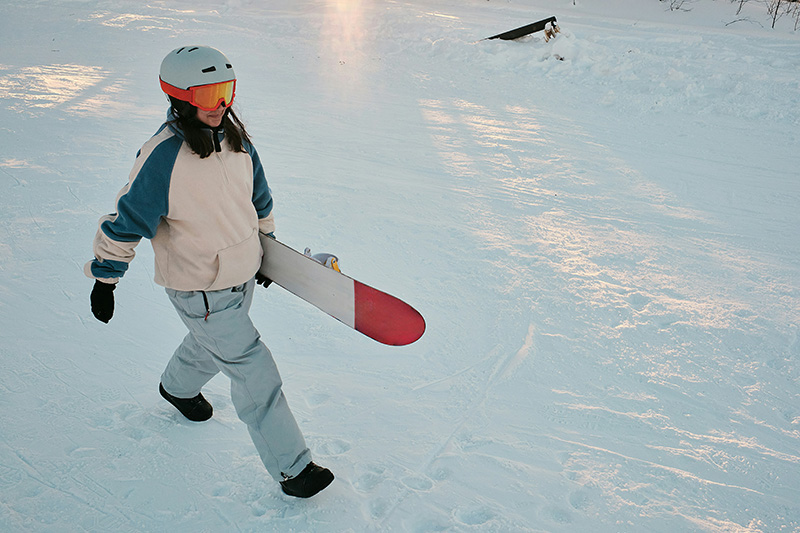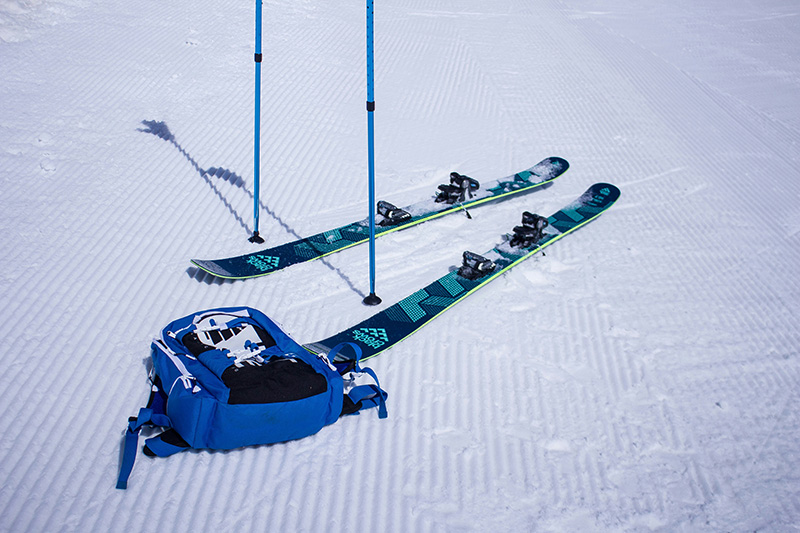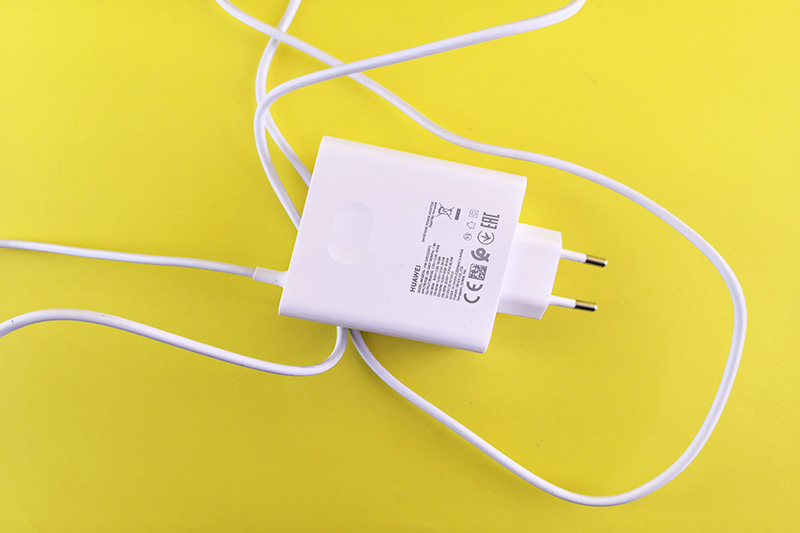Planning your first ski holiday is exciting, but packing for it can feel a bit overwhelming. You’re thinking about this and that, and once you start searching online you’ll find endless lists that only add to the confusion.
As long as you’ve got the basics covered, you’ll be cosy, comfortable, and set to make the most of the mountains.This checklist is written for beginners, so instead of feeling overwhelmed by endless online lists, you’ll know exactly what’s worth packing, what you can skip, and a few tips to make things easier.
The Absolute Essentials

You’re probably thinking about how to stay warm, dry, and comfortable when planning your first ski holiday. You don’t need to spend on top-end gear or rush to buy everything at once—it’s better to start with the basics that will keep you going all day on the slopes, whether it’s in the Alps or on an Italian ski holiday.
Here’s what to pack:
- Ski jacket and trousers (salopettes) – These waterproof outer layers keep the snow and wind out. One of each is plenty for your whole trip.
- Base layers (thermals) –Long-sleeved tops and leggings that sit close to your skin. Pack a couple of sets so you can rotate them during the week.
- Mid layer – Bring a fleece or lightweight jumper to layer up when it’s colder. It adds warmth without being bulky, and while you might not need it every day, it’s perfect for chilly mornings.
- Ski socks – Don’t forget to bring ski socks that will keep you warm, with padding around the shins and ankles so you won’t get rubbing in your ski boots.
- Gloves or mittens – Pack a pair of ski gloves with wrist straps so you don’t lose them on the chairlift. These gloves also give you more grip for zips and buckles.
- Goggles – The light on the slopes is much harsher than you expect. A good pair of goggles helps you see clearly and stops snow whipping into your eyes.
- Helmet – Bring or rent a helmet, but it’s better to rent one first along with your skis and boots so you don’t waste money. If you decide you enjoy skiing, you can always buy your own later.
Tip: Avoid cotton layers. Once it’s wet, it stays wet—stick to synthetics or wool instead.
Off-the-Slopes Clothing
You won’t spend much time out of ski gear, so don’t overpack. Evenings in resort are usually laid-back, and most people just wear their ski jacket when heading out. A couple of comfy outfits are plenty, whether you’re relaxing at the hotel or enjoying a bit of après ski in town.
- Casual clothes – Jeans, leggings, or joggers with a jumper or hoodie work well. You’ll only need one or two sets for the week.
- Warm footwear – Snow boots are ideal, not just for warmth but for grip on icy streets. Trainers are fine indoors.
- Lighter layers – Hotel rooms and chalets are often very warm, so pack a T-shirt or something cooler too.
- Swimwear and flip-flops – Many resorts have pools or spas, and some require flip-flops in those areas.
- One smarter outfit – Optional, but nice if you plan a sit-down dinner or special evening.
Tip: Don’t stress about style—comfort always wins, and nobody expects you to pack a new outfit for every night.
Toiletries and Useful Extras
These are the little things that make a big difference on the mountain. Resorts sell them, but usually at a steep price, so it’s worth packing your own.
- Lip balm with SPF – Your lips might dry out quickly in the cold and wind, and the sun at altitude makes it worse. Keep one in your jacket so you can top up on the lift.
- Sun cream – Snow can reflect the sun straight back at you, so you might burn faster than you expect. A small tube of the best sunscreen for skiing, high factor and pocket-sized, is enough to see you through the week.
- Moisturiser – Hotel heating can make your skin feel dry and itchy. A simple hand or face cream will help.
- Pain relief and plasters – Handy if you end up with sore muscles, a blister, or a headache after a long day.
- Contact lenses and solution (if you use them) – Cold wind might dry your eyes out faster than usual, so it’s worth having spares.
- Hand warmers – Small, cheap, and brilliant for icy mornings or long chairlift rides.
Tip: Pack travel-sized toiletries to save space. If you forget something, you can always buy it in resort—but expect to pay double.
Nice-to-Haves (If You’ve Got the Space)

You don’t need these to enjoy your first ski holiday, but they’re the small extras that experienced skiers quietly swear by.
- Neck warmer or buff – A normal scarf gets wet and heavy; a buff dries quickly and fits neatly under a helmet.
- Glove liners – On freezing days, they give you extra warmth. They’re also easy to swap and dry if your main gloves get damp.
- Small backpack or slope bag – Handy for water and a snack, but also for stashing a layer if the sun comes out.
- Snacks – Mountain cafés can be surprisingly expensive, so slipping a cereal bar in your pocket saves both time and money.
What You Don’t Need to Pack
It’s easy to overpack for your first ski holiday—but a lot of things that seem essential at home just won’t get used in resort. Save yourself the space (and weight) by leaving these behind:
- Your own skis, boots, or poles – Hiring is the norm for beginners. It saves you lugging heavy kit through airports and guarantees equipment that actually fits.
- Extra jeans and jumpers – You’ll spend most of the day in ski gear. One or two outfits for evenings is more than enough.
- Bulky coats – Your ski jacket doubles as your winter coat, whether you’re on the slopes or walking to dinner.
- Smart shoes or heels – Resort streets can be icy and steep. Warm, grippy footwear is all you’ll need.
- Family-sized toiletries – Full bottles take up valuable luggage space. Travel-sized ones last the week, and anything you forget can be picked up locally.
Remember: Almost everything can be hired, borrowed, or bought once you're there. Don't let packing lists convince you to bring more than you'll actually use.
Travel Documents and Journey Tips

It’s not only your ski gear you need to think about. If you forget the important paperwork, your holiday might turn into a hassle before it even starts.
Here are some of the things you’ll want to keep together in one safe place:
- Passport – Check the expiry date well before you travel.
- Travel insurance details – Even if it’s your first time skiing, make sure your policy covers winter sports.
- Lift pass or booking confirmation – Some can be pre-ordered, others collected in resort.
- Boarding passes or tickets – Digital copies on your phone are handy backups, and if you’re travelling on a coach holiday in Italy, keeping a printed copy as well makes boarding smoother.
- Chargers and adapters – Many European resorts use two-pin plugs.
- Emergency contacts – Store them in your phone and on paper, just in case.
Advice We Always Give First-Time Skiers
Don’t feel like you need to pack everything. Hire the gear you’re unsure about and keep your packing simple. Layer up, but don’t overdress because you’ll warm up once you start moving. Most importantly, pace yourself—skiing is tiring, so take breaks and enjoy the cafés and views along the way.
With Interski Holidays, you don't have to worry about juggling bookings. Our team is in resort, we have our own ski hire, and the biggest British-run ski school in the Alps is just for our guests. From lift passes to equipment and a place to stay, we’ve got it covered.
If it’s your first time skiing, send us a message and we’ll handle the details, leaving you free to enjoy the experience.
.jpg)
.jpg)
.jpg)
.jpg)